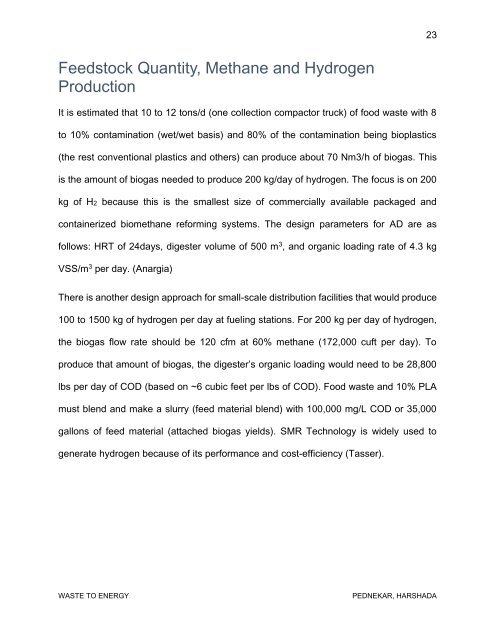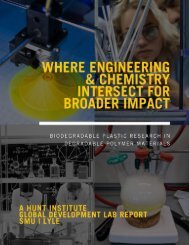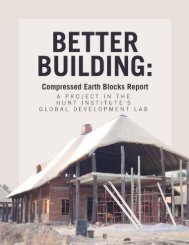Waste to Energy: Harnessing the fuel in organic waste to create a business opportunity for a recycling-based society and system
To generate a feasible amount of methane to support a digester, it is estimated that 10 to 12 tons/d, with 8-10% contamination and 80% of the contamination being bioplastics, can produce about 70 Nm3/h of biogas. This is the amount of biogas needed to produce 200 kg/day of hydrogen, which is the smallest commercially available packaged system. The greenhouse gas emission (GHG) for IngeoTM is currently 1.3 kg CO2 eq./kg polymer compared to approx. 3.2 kg CO2 eq./kg polymer for PET. Therefore, implementing anaerobic digestion for PLA can reduce around 942.5 kg - 1132 kg per day of CO2 equivalent emissions. A total of 1 ton per day of undigested bioplastic with 30% of total solids will be sent to landfills; 3 tons per day of dewatered digestate cake can be utilized for composting, and Class A fertilizer can be produced. The research on anaerobic degradation of biopolymers is still in its infancy. Therefore, this report has discussed different pre-treatment alternatives to treat PLA such as physical, chemical, and thermal treatments. This report suggests on-site segregation benefits of the current solid waste management scenario in the commercial sector of Plano, Texas. Organic waste generated from a cafeteria of the commercial sector in Plano caused an environmental impact on landfills. This report consists of a description of existing scenarios and possible pre-treatment alternatives for bioplastic degradation generated from the commercial sector. Harshada Pednekar was a graduate research analyst in the Hunt Institute while studying for a masters degree in environmental engineering from SMU's Lyle School of Engineering
To generate a feasible amount of methane to support a digester, it is estimated that 10 to 12 tons/d, with 8-10% contamination and 80% of the contamination being bioplastics, can produce about 70 Nm3/h of biogas. This is the amount of biogas needed to produce 200 kg/day of hydrogen, which is the smallest commercially available packaged system. The greenhouse gas emission (GHG) for IngeoTM is currently 1.3 kg CO2 eq./kg polymer compared to approx. 3.2 kg CO2 eq./kg polymer for PET. Therefore, implementing anaerobic digestion for PLA can reduce around 942.5 kg - 1132 kg per day of CO2 equivalent emissions.
A total of 1 ton per day of undigested bioplastic with 30% of total solids will be sent to landfills; 3 tons per day of dewatered digestate cake can be utilized for composting, and Class A fertilizer can be produced. The research on anaerobic degradation of biopolymers is still in its infancy. Therefore, this report has discussed different pre-treatment alternatives to treat PLA such as physical, chemical, and thermal treatments. This report suggests on-site segregation benefits of the current solid waste management scenario in the commercial sector of Plano, Texas. Organic waste generated from a cafeteria of the commercial sector in Plano caused an environmental impact on landfills. This report consists of a description of existing scenarios and possible pre-treatment alternatives for bioplastic degradation generated from the commercial sector.
Harshada Pednekar was a graduate research analyst in the Hunt Institute while studying for a masters degree in environmental engineering from SMU's Lyle School of Engineering
Create successful ePaper yourself
Turn your PDF publications into a flip-book with our unique Google optimized e-Paper software.
23<br />
Feeds<strong>to</strong>ck Quantity, Methane <strong>and</strong> Hydrogen<br />
Production<br />
It is estimated that 10 <strong>to</strong> 12 <strong>to</strong>ns/d (one collection compac<strong>to</strong>r truck) of food <strong>waste</strong> with 8<br />
<strong>to</strong> 10% contam<strong>in</strong>ation (wet/wet basis) <strong>and</strong> 80% of <strong>the</strong> contam<strong>in</strong>ation be<strong>in</strong>g bioplastics<br />
(<strong>the</strong> rest conventional plastics <strong>and</strong> o<strong>the</strong>rs) can produce about 70 Nm3/h of biogas. This<br />
is <strong>the</strong> amount of biogas needed <strong>to</strong> produce 200 kg/day of hydrogen. The focus is on 200<br />
kg of H2 because this is <strong>the</strong> smallest size of commercially available packaged <strong>and</strong><br />
conta<strong>in</strong>erized biomethane re<strong>for</strong>m<strong>in</strong>g <strong>system</strong>s. The design parameters <strong>for</strong> AD are as<br />
follows: HRT of 24days, digester volume of 500 m 3 , <strong>and</strong> <strong>organic</strong> load<strong>in</strong>g rate of 4.3 kg<br />
VSS/m 3 per day. (Anargia)<br />
There is ano<strong>the</strong>r design approach <strong>for</strong> small-scale distribution facilities that would produce<br />
100 <strong>to</strong> 1500 kg of hydrogen per day at <strong>fuel</strong><strong>in</strong>g stations. For 200 kg per day of hydrogen,<br />
<strong>the</strong> biogas flow rate should be 120 cfm at 60% methane (172,000 cuft per day). To<br />
produce that amount of biogas, <strong>the</strong> digester’s <strong>organic</strong> load<strong>in</strong>g would need <strong>to</strong> be 28,800<br />
lbs per day of COD (<strong>based</strong> on ~6 cubic feet per lbs of COD). Food <strong>waste</strong> <strong>and</strong> 10% PLA<br />
must blend <strong>and</strong> make a slurry (feed material blend) with 100,000 mg/L COD or 35,000<br />
gallons of feed material (attached biogas yields). SMR Technology is widely used <strong>to</strong><br />
generate hydrogen because of its per<strong>for</strong>mance <strong>and</strong> cost-efficiency (Tasser).<br />
WASTE TO ENERGY<br />
PEDNEKAR, HARSHADA













